
Posted on 09/12/2014 4:17:03 AM PDT by Homer_J_Simpson


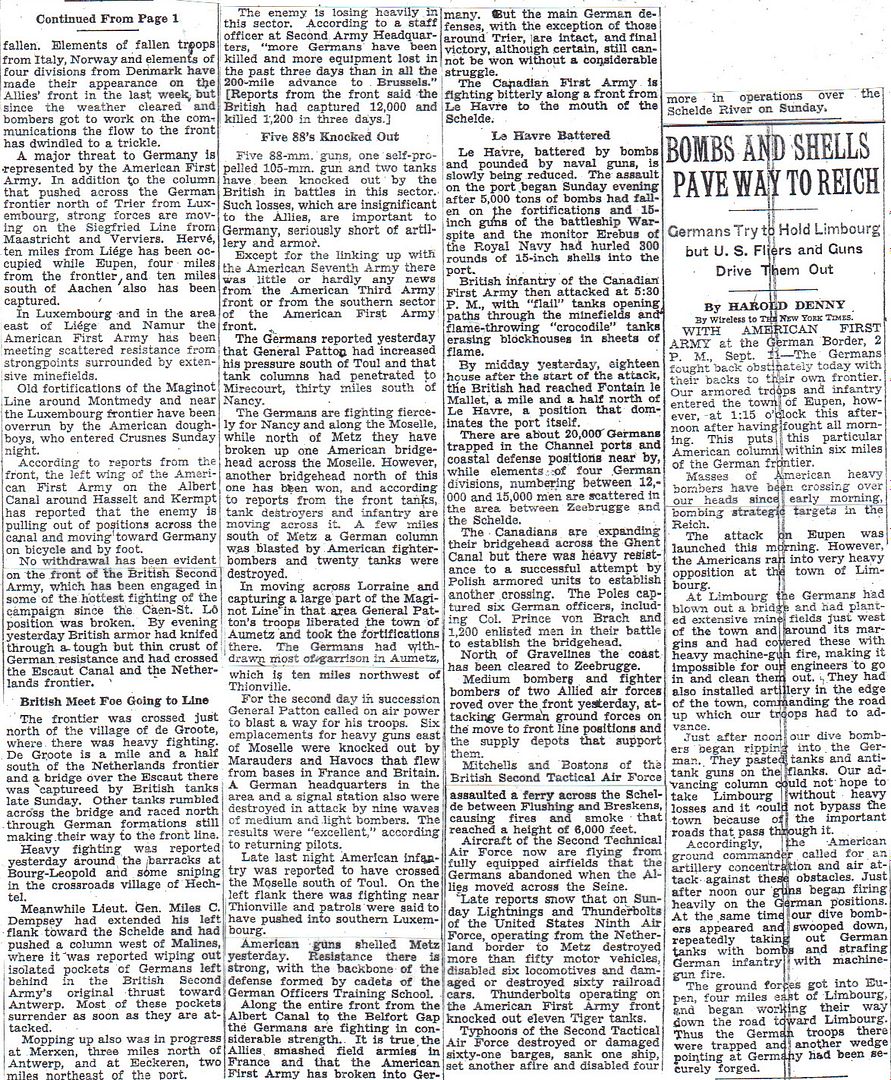
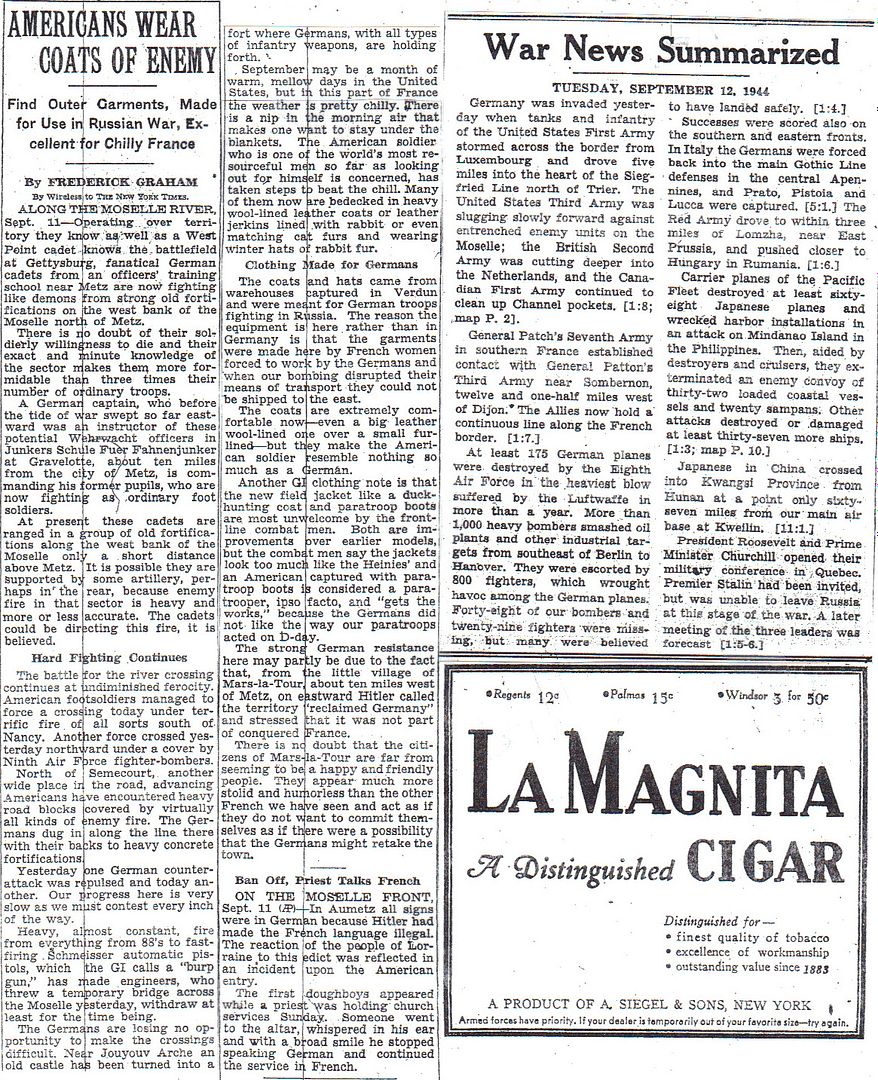
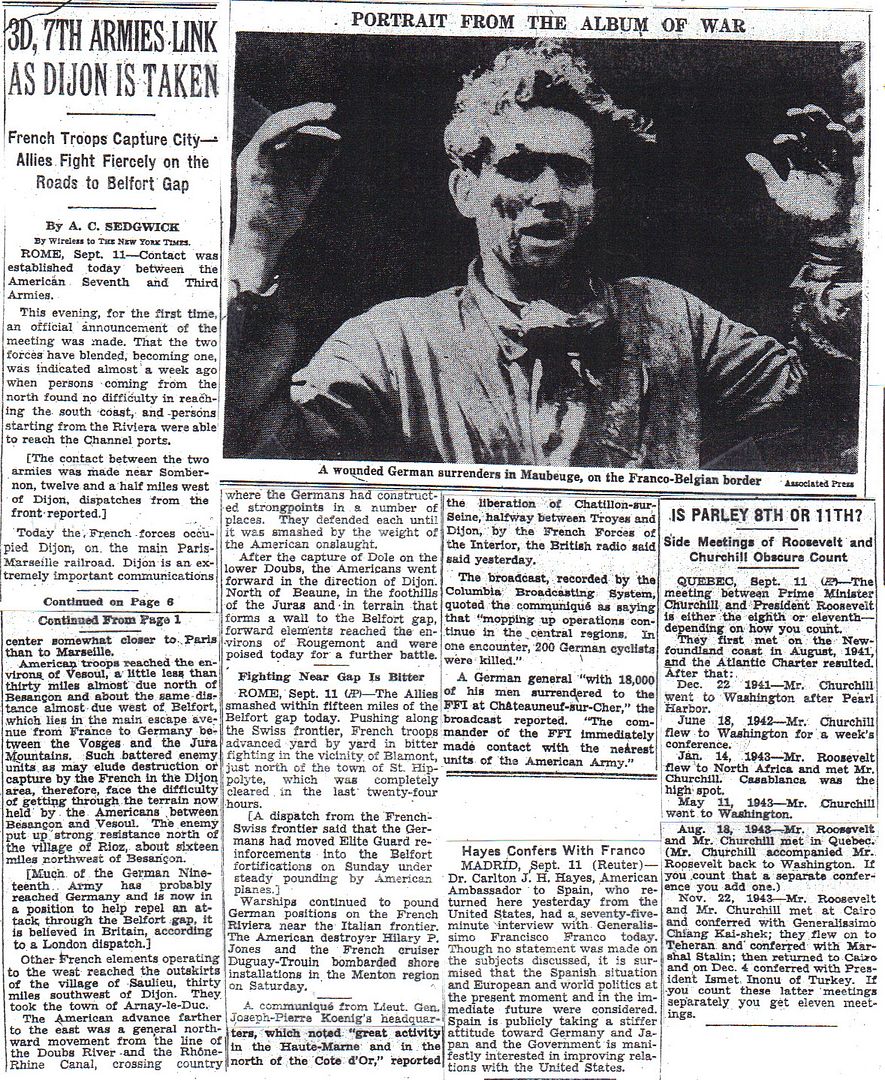
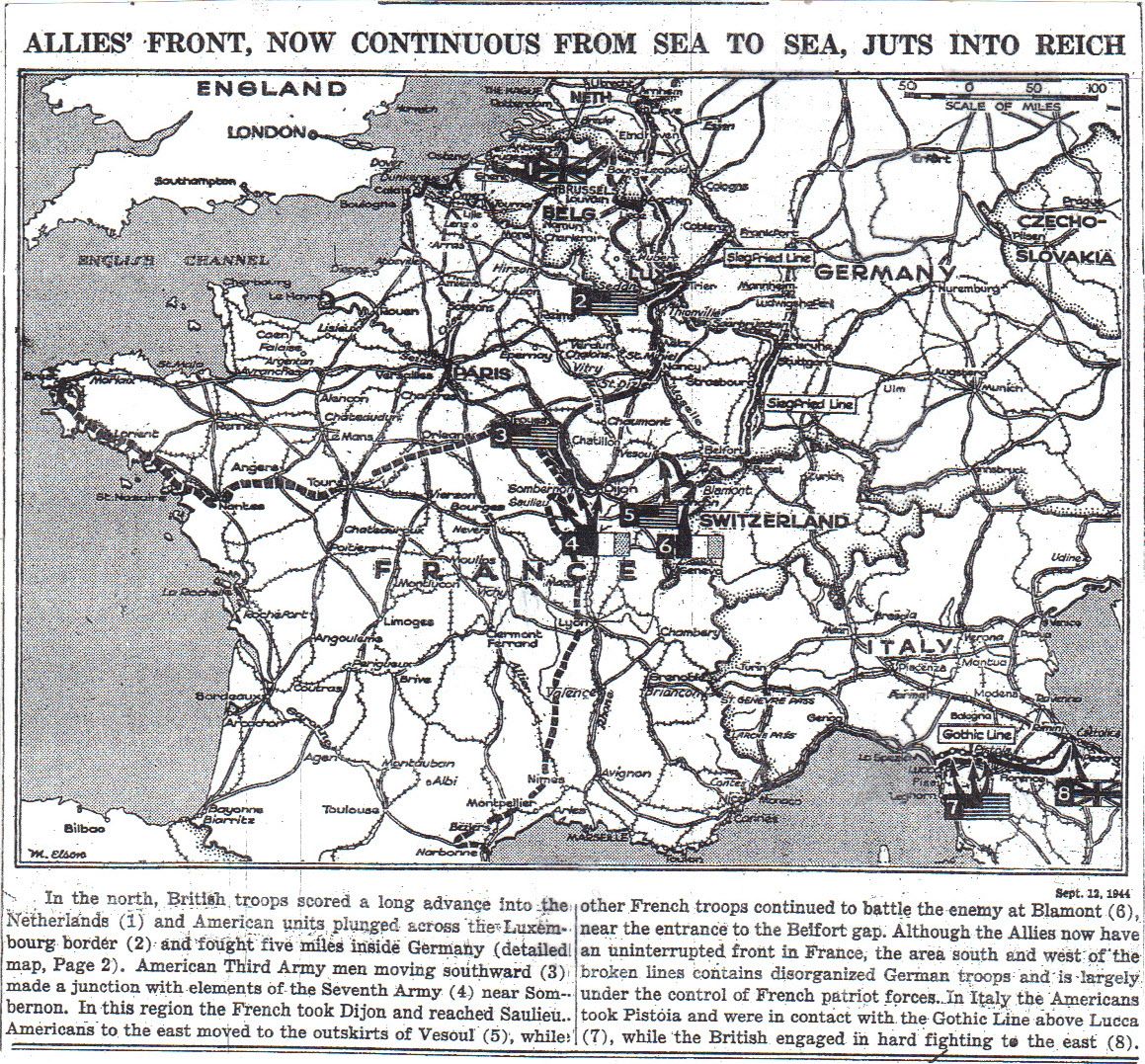
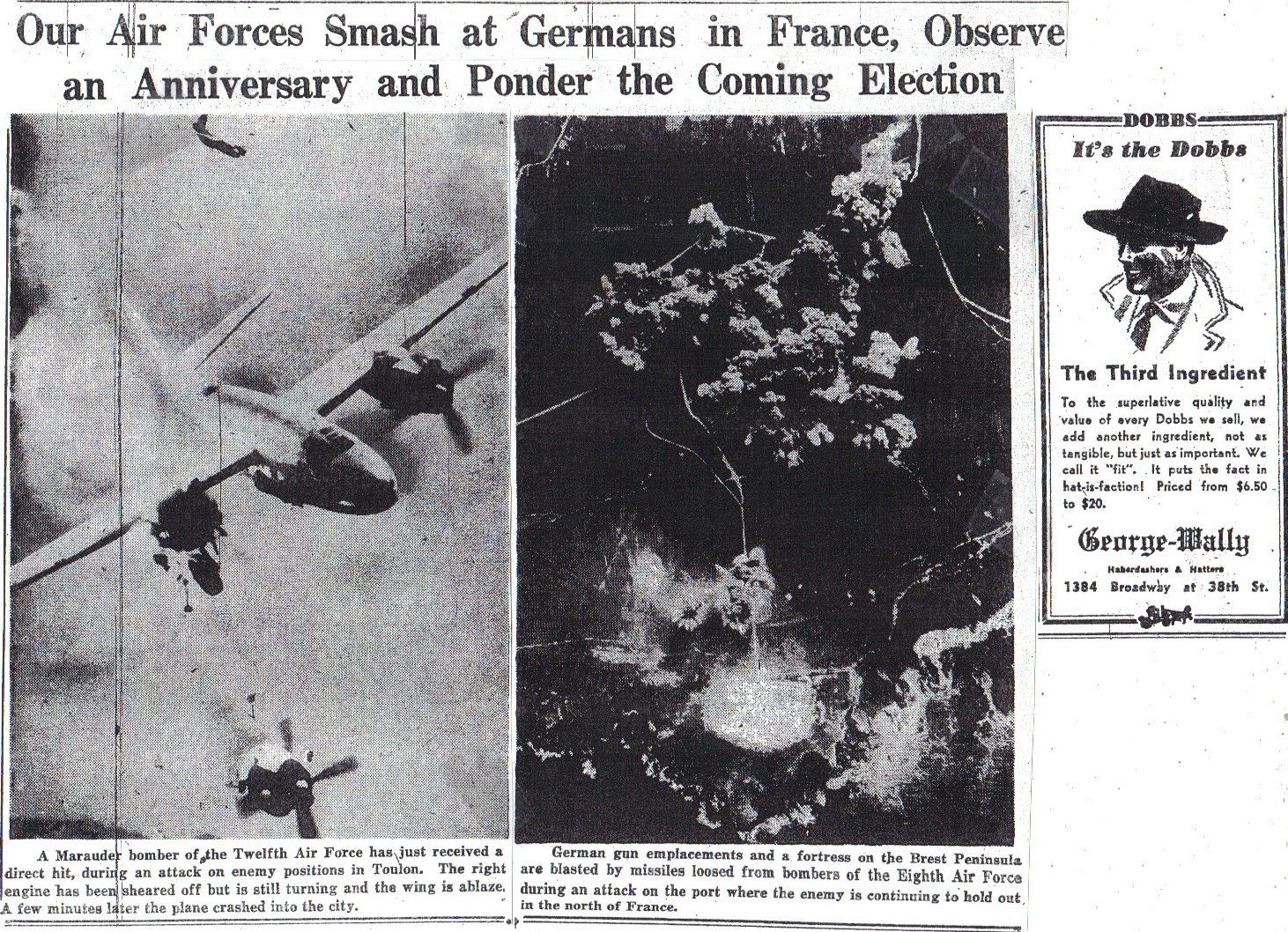
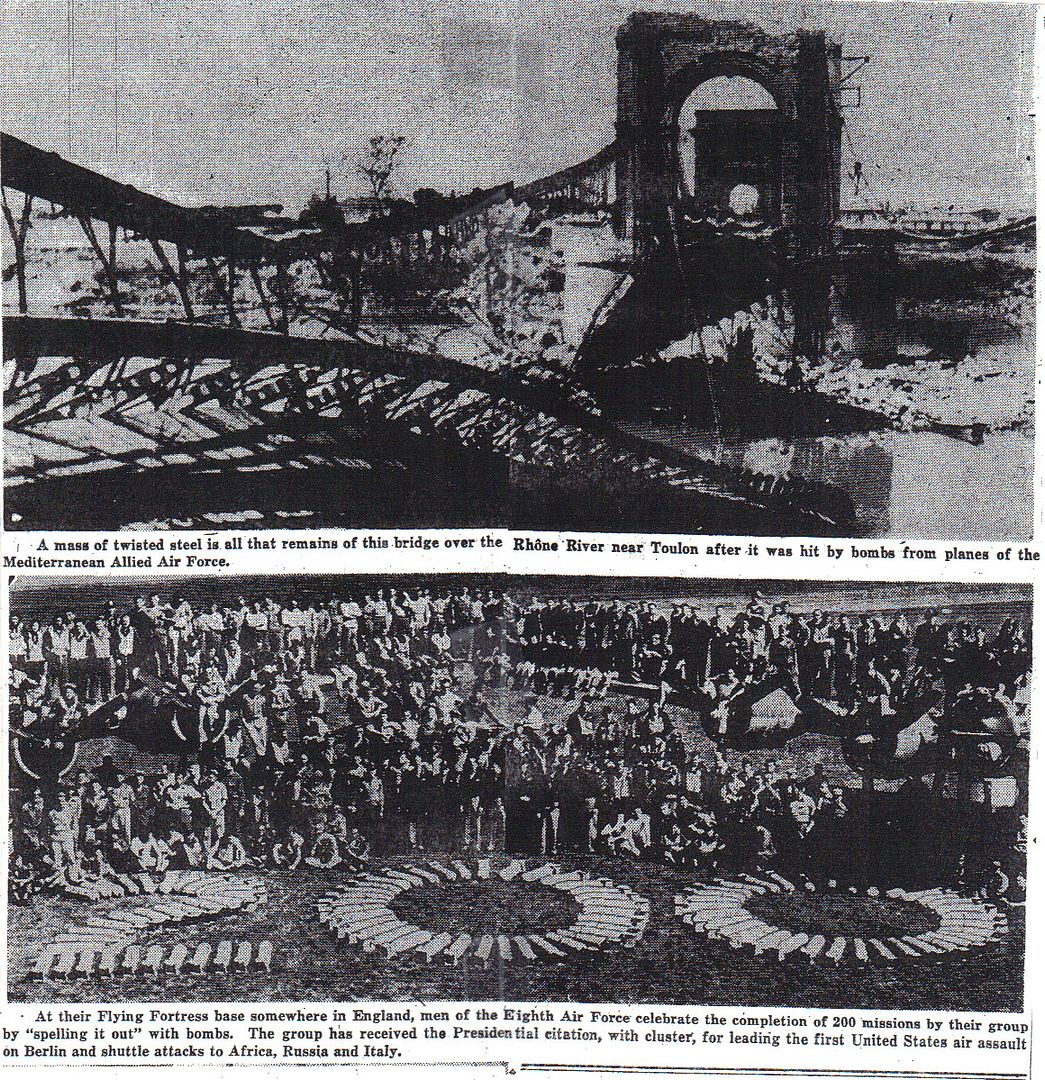


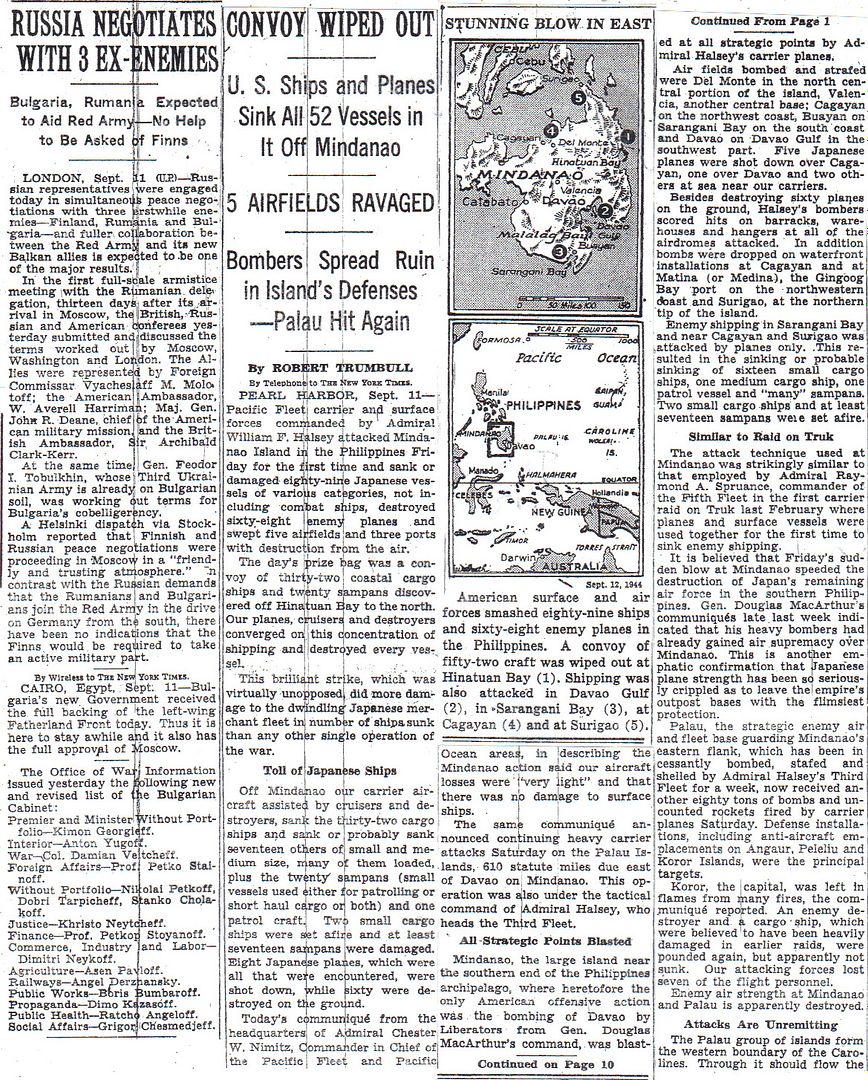
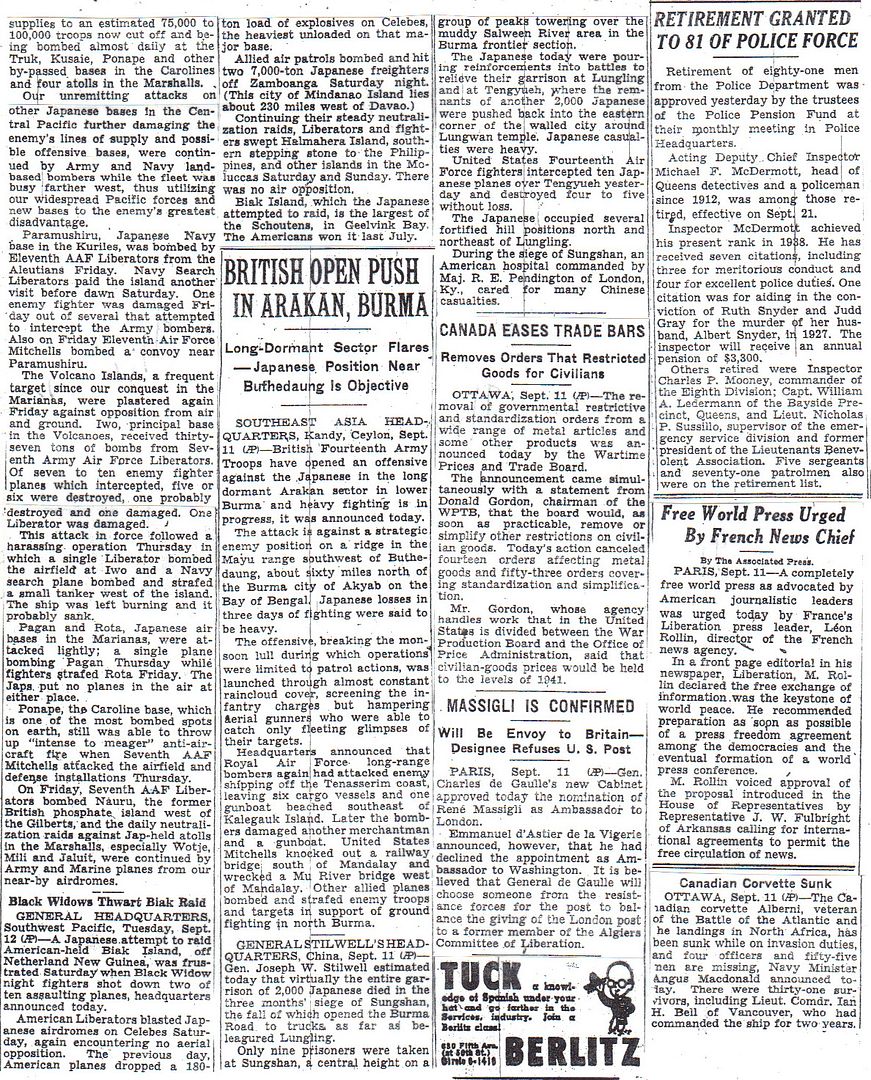
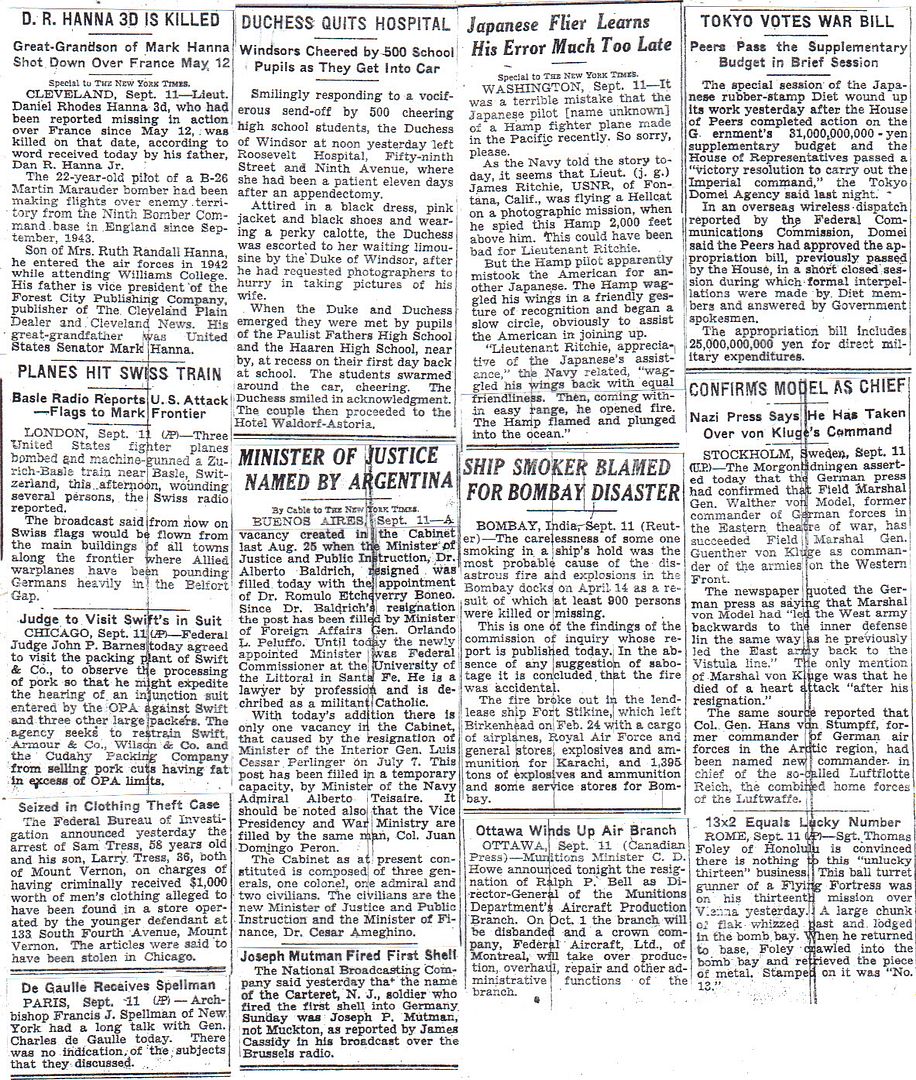
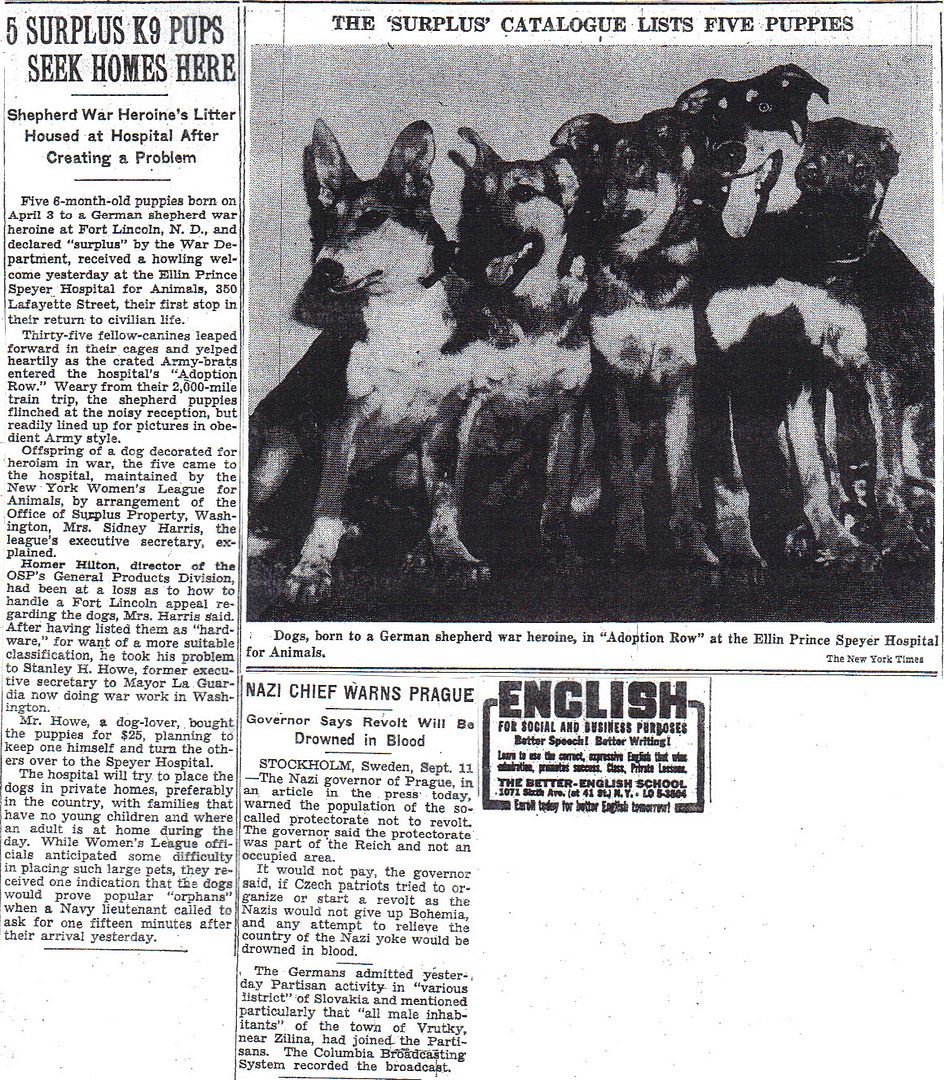
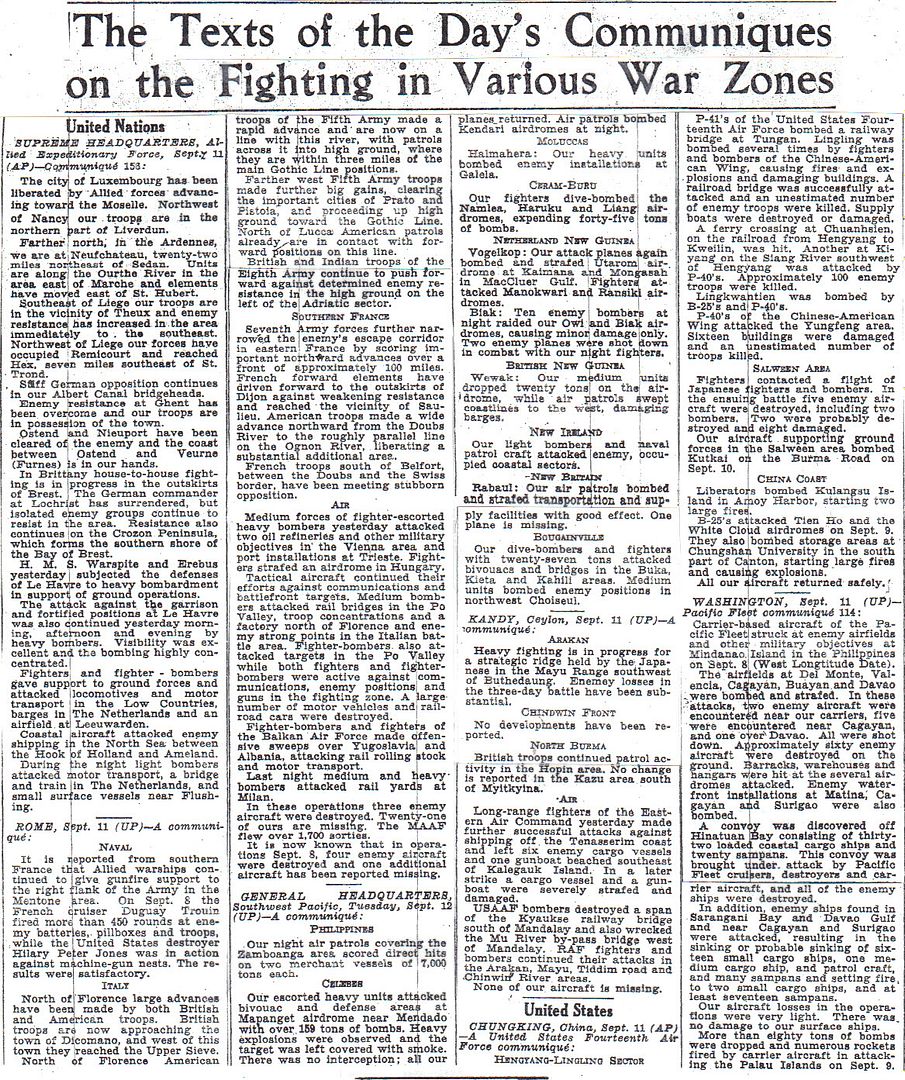
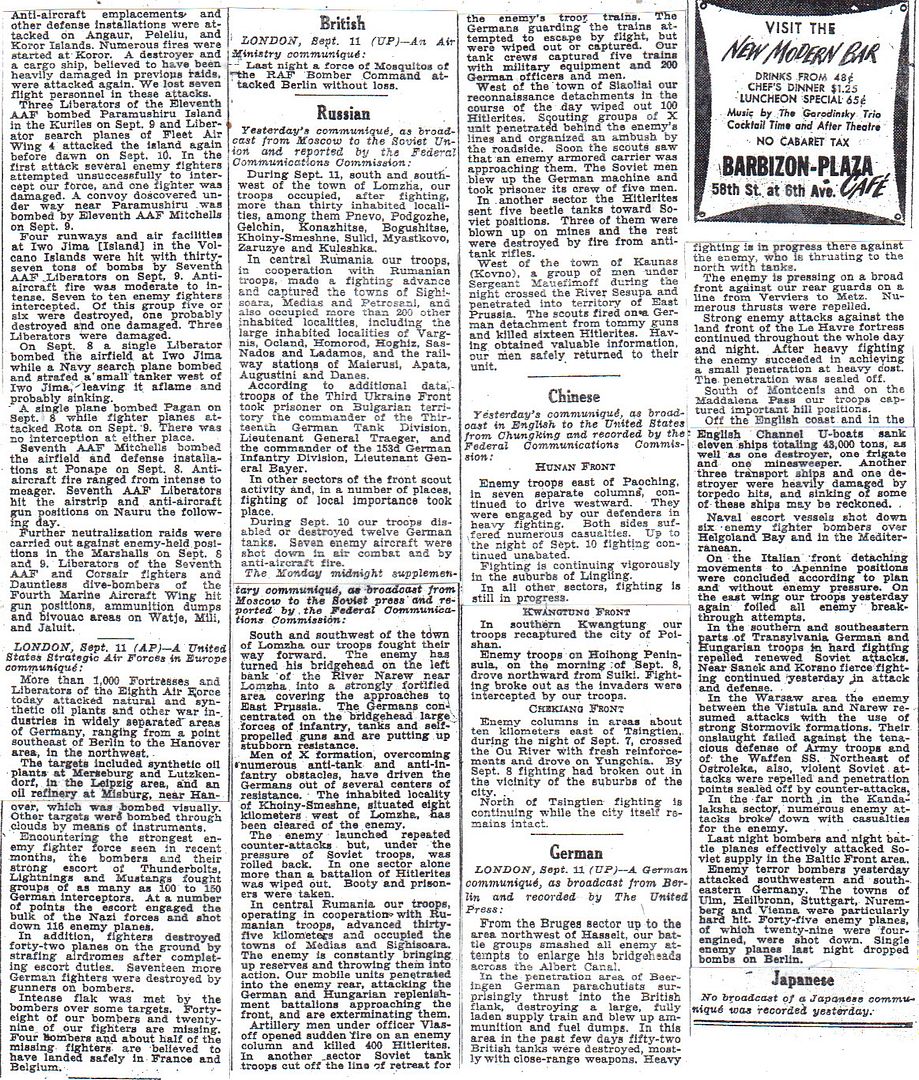
Return address:
Co. F, 128 Inf APO 32
% Postmaster San Francisco
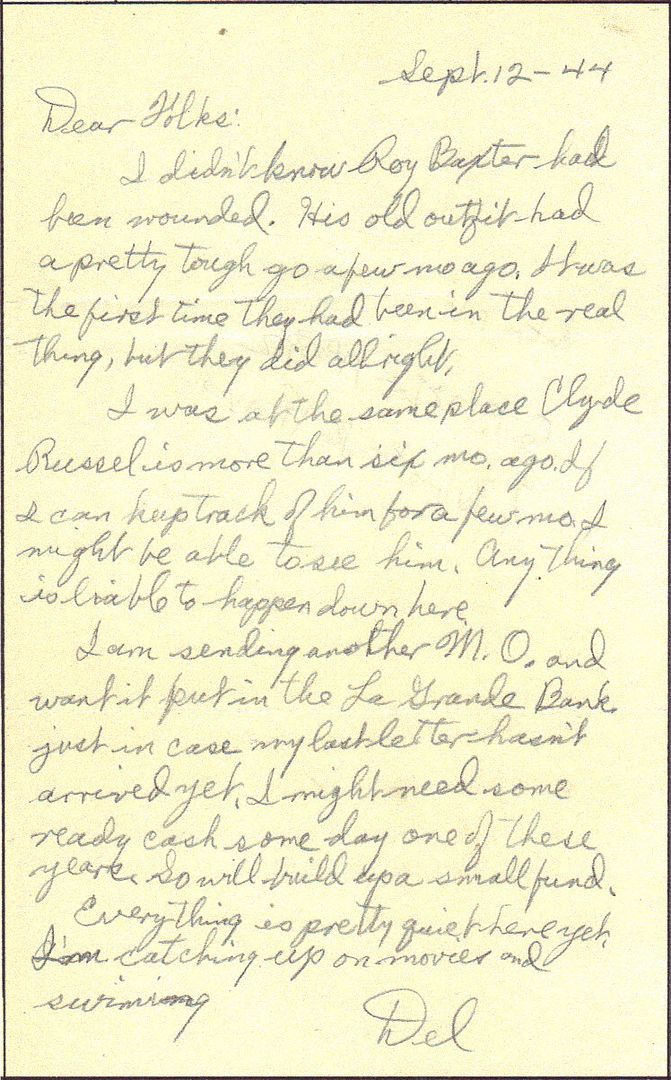
http://www.onwar.com/chrono/1944/sep44/12sep44.htm#
Le Harve garrison surrenders
Tuesday, September 12, 1944 www.onwar.com
Allied shelling of Le Harve before the surrender [photo at link]
On the Western Front... The German garrison of Le Harve, about 12,000 men, surrenders under pressure of attacks by British 1st Corps (part of Canadian 1st Army, British 21st Army Group). Forces of US 1st Army (part of US 12th Army Group) reach the German border between Aachen and Trier.
In the Mediterranean... The German garrison on Mytilene, in the Aegean Sea, is evacuated.
In Liberated Italy... The Greek government in exile arrives in Caserta in the south, from Cairo, in order to be closer to Greece in anticipation of returning.
In Moscow... The Romanian government signs the armistice with the Allies. The terms include reparations to the Soviet Union of $300,000,000 as well as cession of territory to the USSR.
In the Philippines... Three groups of US Task Force 38, with 12 carriers, conduct air strikes on Japanese positions on the Visayas or central Philippine islands.
In Canada... The Octagon Conference continues. Churchill and Roosevelt and their staffs meet in Quebec to discuss strategy.
September 12th, 1944 (TUESDAY)
UNITED KINGDOM: The US Eighth Air Force in England flies 2 missions. Numbers in parenthesis indicate the number of bombers attacking a target.
- Mission 626: For the second day, 888 bombers and 662 fighters, in 3 forces, are dispatched on a major assault on the German oil industry; they are intercepted by 400-450 Luftwaffe fighters; USAAF claims 81-16-20 aircraft in the air; 35 bombers and 12 fighters are lost.
(1) B-17s bomb oil refineries at Brux (79) and Ruhland (59); targets of opportunity are Lauta (48), Plauen (30), Etterwinden (12), Karlsbad (11), Kitzingen (11) and others (21); PFF methods are used for all targets; they claim 14-9-7 aircraft; 19 B-17s are lost; escort is provided by 238 P-47 Thunderbolts and P-51 Mustangs; they claim 29-2-4 aircraft in the air and 21-0-16 on the ground; 10 P-51s are lost.
(2) B-17s bombing visually attack Magdeburg/Rothensee (144), Magdeburg/Friedrichstadt (73) and Bohlen (35); targets of opportunity are Fulda (46), Molbis (11) and other (8); they claim 13-5-5 aircraft; 12 B-17s are lost; escort is provided by 236 P-47s and P-51s; they claim 25-0-4 aircraft in the air and 5-0-15 on the ground; 2 P-51s are lost.
(3) B-24s hit Hemmingstedt (66), Kiel (58) and Misburg (34); targets of opportunity are Laharte (38), marshalling yard at Northeim (12), Hannover (11), Hemmingstedt (3) and other (3); PFF is used for bombing; 4 B-24s are lost; escort is provided by 105 P-38 Lightnings, P-47s and P-51s without loss.
- Mission 627: 7 B-17s drop leaflet in France, the Netherlands and Germany during the night.
- 36 B-24s and C-47s are dispatched on CARPETBAGGER missions during the night.
NETHERLANDS: Five RAF Bomber Command Mosquitos attack Havelte Airfield at Steenwijk.
FRANCE: The French 2nd Armoured Division of the US Third Army links up with the French II Corps at Chatillon-sur-Seine, creating a solid Allied line between the Channel and the Swiss frontier.
12,000 Germans surrender at Le Havre to the British I Corps.
Units of the U.S. Third Army eliminates all resistance west of the Moselle River in the Thionville area and clears Thionville west of the river except for an approach to the main bridge there. The Germans destroy the bridge. At 1200 hours engineers finish bridging the Moselle, thus permitting tanks and tank destroyers of the U.S. 7th Armored Division to cross into the bridgehead. A regiment of the 80th Infantry Division attacks across the Moselle in the Dieulouard area early in the morning and finds the east bank lightly held; another regiment follows just before noon and weapons and vehicles start across later in the day.
In southern France, elements of the French 2d Corps reach the outskirts of Langres.
400+ C-47 Skytrains of the First Allied Airborne Army’s IX Troop Carrier Command complete supply and evacuation missions.
The USAAF Ninth Air Force flies tactical missions attacking fortifications around Nancy while fighters continue ground support in the French/German border area.
In southern France, the 54 B-24 Liberators of the USAAF Fifteenth Air Force based in Italy fly a supply mission.
The “Dallas Lady” a B-24 of the USAAF flying from Algiers, flies over the Southern French Alps to deliver arms to the French resistance. She flies too low and crashes on the rocks of the Ubaquet, between the pass of the Colle Rousse and the peak of the Corne-de-bouc, north-east of Turin at an altitude of 1950 m. The pilot Major, Eart A. Desjardins, and his ten companions are all killed. (Michel Hartinger )
BELGIUM: German forces fall back behind the Escaut Canal.
The Polish 1st Armoured Division pushes forward to Lokeren and St Nicholas while the 4th Armoured Division clears the Bruges area and reaches the Leopold Canal. The U.S. 2d Armored Division reconnaissance battalion clears the bridge site along the north bank of the Albert Canal and the bridge is completed there at midnight. Combat Command A of the 2d Armored Division begins crossing the bridge immediately.
GERMANY: The U.S. 1st Infantry Division thrusts at Aachen Municipal Forest, south of Aachen, where it repels a counterattack. One U.S. 3d Army Division column, driving northeast from Eupen, stops for the night on the edge of Eynattener Wald, within about 1,000 yards (914 meters) of the West Wall; another column probes east from Eupen, some elements reaching the West Wall at Schmidthof and others reaching Roetgen, just short of the West Wall. Major General J. Lawton Collins, Commanding General VII Corps, decides to bypass Aachen, isolating it in conjunction with the XIX Corps, and drive toward the Stolberg corridor. The V Corps begins limited attacks against the West Wall.
The USAAF Ninth Air Force flies tactical missions with B-26 Marauders and A-20 Havocs hitting Westwall fortifications and the Sankt Wendel station, where an armored division and important technicians are to entrain.
The USAAF Fifteenth Air Force sends nearly 330 B-17 Flying Fortresses and B-24 Liberators supported by P-38 Lightnings and P-51 Mustangs to bomb three targets: 263 B-17s bomb Lechfeld Airfield at Munich; 91 B-24s bomb the Allach engine works producing engines for the FW 190 at Munich; and 78 B-24s bomb the Wasserburg jet aircraft factory.
During the day, RAF Bomber Command dispatched 412 aircraft, 315 Halifaxes, 75 Lancasters and 22 Mosquitos, to attack three synthetic oil plants:141 hit the Buer plant at Gelsenkirchen, 120 hit the Krupp Treibstoff plant at Wanne-Eikel, and 110 hit the Hoesch plant at Dortmund. The Dortmund raid is particularly successful, but smoke-screens prevented observation of results at the other targets. Seven aircraft are lost. In a second raid, 119 Halifaxes and five Pathfinder Lancasters carried out the first raid by RAF heavies on Münster since June 1943; 121 aircraft bombed the target. Two Halifaxes are lost. Many fires are seen but smoke prevented an accurate assessment of the bombing results. A brief report from Münster describes a “sea of fire” in the southern part of the town which could not be entered for several hours and tells of water mains destroyed by high-explosive bombs so that “the firemen could only stand helpless in front of the flames.” The railway station in the heart of the city is one of the targets.
During the night of 12/13 September, RAF Bomber Command sends 378 Lancasters and nine Mosquitos on the last major RAF raid of the war against Frankfurt-am-Main; 366 bomb the city. Seventeen Lancasters are lost, 4.5 per cent of the Lancaster force. The local report says that the raid occurred when many of the city’s firemen and rescue workers are away working in Darmstadt. The bombing caused severe destruction in the western districts of the city, which contained many industrial premises. Property damage is extensive. A troop train is hit at the West Station. A second target is Stuttgart with 204 Lancasters and 13 Mosquitos dispatched; 211 bomb the target with the loss of four Lancasters. The attack is a success and local reports state that a firestorm occurred. A third target is Berlin with 29 Mosquitos bombing.
U-2331 commissioned.
U-993 - One man from the boat died of jaundice in the North Atlantic. [Matrosenobergfreiter Wilhelm Lucksnat].
U-3517 and U-3518 laid down.
CZECHOSLOVAKIA: The USAAF Eighth Air Force based in England bombs three targets: 78 bomb the synthetic oil refinery at Brux; 11 bomb the industrial area at Karlsbad; and two bomb targets of opportunity.
HUNGARY: The Germans and Hungarians begin a counter-offensive toward Arad and Temesvar.
NORWAY: Twelve RAF Bomber Command Halifaxes are dispatched to mine Oslo harbor; only one aircraft lays mines and it is lost; the other eleven are recalled.
U.S.S.R.: Moscow: The armistice treaty between Romania and the Allies here today stipulates that the Romanians must pay the Soviet Union £75 million for damage caused in Russia by the Romanian army. Another key clause stipulates that the Soviet Union will keep Bessarabia and Northern Bukovina according to the terms of the 1940 treaty under which they were ceded to the Soviet Union. In recompense Romanian will get back that portion of Transylvania which Hitler gave to Hungary under the 1940 Vienna Award. The terms, signed by the newly-promoted Marshal Malinovsky, also commit Romania to “wage war against Germany and Hungary.”
ITALY: The South African 6th Armoured Division continues to gain ground as the Germans fall back to prepared positions of the Gothic Line.
US Twelfth Air Force B-26s blast defended positions in the central battle sector of the Gothic Line; B-25s pound Po River railroad bridges and attack guns and strongpoints in the battle zone as the enemy falls back to prepared Gothic Line defenses and the rapid Allied advance halts; fighter-bombers strike at guns, troop concentrations, strongpoints, and flak positions in the Genoa and Milan areas.
The exiled Greek government moves from Cairo, Egypt to Caerta.
GREECE: German troops evacuate Rhodes and other Greek islands in the eastern Mediterranean.
CHINA: Twenty five USAAF Tenth Air Force B-24 Liberators haul fuel from India to Kunming.
Twenty two USAAF Fourteenth Air Force B-25 Mitchells attack Kaochishih and Tunghsiangchiao and the Kiyang area; 14 B-25s attack the town area and bridges in and around Sungpai; ten B-25s and six P-40s attack Lungling; and 27 P-40s and P-51 Mustangs attack targets across a wide area of east central China.
BURMA: USAAF Tenth Air Force B-24 Liberators bomb the Katha area; eight P-47 Thunderbolts conduct a sweep along the Irrawaddy River from Bhamo to Katha; three P-47s strafe building in Katha; and 16 P-47s attack Loiwing Airfield and targets of opportunity along the Burma Road from Lungling, China, to Wanling and Namhkam.
COMMONWEALTH OF THE PHILIPPINES: Carrier-based aircraft of the USN’s Task Groups 38.1, 38.2 and 38.3 attack Japanese installations on Cebu. The aircraft also attack shipping and sink 20 vessels.
Carrier-based aircraft of the USN’s Task Groups 38.1, 38.2 and 38.3 attack Japanese installations on Cebu. The aircraft also attack shipping and sink 20 vessels.
Ensign Thomas C. Tillar, USNR, a pilot from USS Hornet (CV-12), in TG 38.1, is rescued by Filipinos after his F6F Hellcat ditches off Apit Island, off the southwestern coast of Leyte. Before Tillar is recovered by SOC Seagull from heavy cruiser USS Wichita (CA-45), he learns from his rescuers that the size of the Japanese garrison on Leyte is negligible. That fact, when combined with the lack of aerial opposition encountered and the few airfields that exist on Leyte and Samar, prompts Admiral Halsey, Commander Third Fleet, to recommend that the planned attack on Yap Island in the Carolines be abandoned and that the date of the landings on Leyte be advanced from 20 December to 20 October 1944.
KURILE ISLANDS: 6 US Eleventh Air Force bombers fly a negative shipping sweep over Shimushu Island; 3 more attack Suribachi Airfield and offshore shipping targets; 1 B-24 flies negative reconnaissance.
EAST INDIES: In Portugese Timor, USAAF Fifth Air Force B-24 Liberators bomb Lautem. In the Netherlands East Indies, USAAF Far East Air Force B-24s bomb Manado, Mapenget and Sidate Airfields on Celebes Island. B-24 Liberators bomb Djailolo and Kaoe Airdromes on Halmahera Island, and USAAF Fifth Air Force B-25 Mitchells bomb radar facilities on Morotai Island. P-38 Lightnings dive-bomb Namlea Airfield on Buroe Island while P-47 Thunderbolts hit Boela Airdrome on Ceram Island.
NEW GUINEA: A-20s, B-25s, and fighter-bombers hit airfields, AA guns, and other targets at Babo, Mongosah, Manokwari, Sagan, Moemi, and Samate.
PALAU ISLANDS: Carrier-based aircraft of Task Group 38.4 plus escort aircraft carriers, begin the final pre-invasion attacks on Peleliu Island.
The escort aircraft carriers involved are:
Task Group 30.7, the Antisubmarine Warfare Group
USS Hoggatt Bay (CVE-75) with Composite Squadron Fourteen (VC-14)
Task Group 30.8, the At Sea Logistics Service Group:
USS Barnes (CVE-20), an aircraft transport
USS Nassau (CVE-16), an aircraft transport
USS Nehenta Bay (CVE-74) with VC-11
USS Rudyerd Bay (CVE-81) with VC-77
USS Sargent Bay (CVE-83) with VC-79
USS Sitkoh Bay (CVE-86), an aircraft transport
USS Steamer Bay (CVE-87), an aircraft transport
Task Group 32.7.1, the Covering Force
USS Kadashan Bay (CVE-76) with VC-20
USS Marcus Island (CVE-77) with VC-21
USS Ommaney Bay (CVE-79) with VC-75
USS Savo Island (CVE-78) with VC-27.
PACIFIC OCEAN: USN submarines sink seven Japanese ships: USS Pampinito (SS-383) sinks a merchant passenger/cargo ship (ex-U.S. passenger liner SS President Harrison) and a tanker north of Luzon, Philippine Islands. Returning to the scene 3 days later, Pampinito will find and rescue 73 Australian and British POWs. The convoy had been transporting over 2000 POWs from the Philippines to Japan. Other US submarines are dispatched to pick up survivors. Many POWs were picked up by the Japanese and continued to Japan. Now part of the National Maritime Museum, she is on display at San Francisco, USA, since 1982.
Other submarine victories include (1) USS Growler (SS-215) sinks the destroyer HIJMS Shikinami 240 miles (386 kilometres) south of Hong Kong and an escort vessel 250 miles (402 kilometres) east of Hainan Island: (2) USS Pipefish (SS-388) sinks an auxiliary vessel off Shiono Misaki, Japan; and (3) USS Sealion (SS-315) sinks a transport and a merchant passenger/cargo ship in the South China Sea, east of Hainan Island.
High speed transport USS Noa sunk in collision with destroyer USS Fullam off Palau.
CANADA: Corvette HMCS Brantford completed refit Sydney, Nova Scotia.
U.S.A.: Minesweepers USS Rebel and Prime commissioned.
Escort carrier USS Cape Gloucester launched.
Coast Guard-manned Army vessel FS-316 was commissioned at New York with LTJG J. B. Funk, Jr., USCGR, as first commanding officer. LT M.S. Hanson, Jr., USCG succeeded him on 7 November 1944. She departed New York in October 1944 for the Southwest Pacific where she operated during the war.
Coast Guard-manned Army vessel FS-351 was commissioned at the J. K. Welding Company, Yonkers, NY with LTJG Frederick Sturges, III, USCGR, as commanding officer. She departed New York on 12 October 1944, for the Southwest Pacific where she operated during the war at Hollandia and elsewhere.
ATLANTIC OCEAN: U-518 damaged SS George Ade.
"On July 8, 1944, three weeks before the Soviets liberated the Kovno (Lithuania) Ghetto, the Nazis forced Jews from underground bunkers with dogs, smoke grenades, and firebombs.
Two thousand Jews died, while 4,000 others were sent to camps in Germany.
The Germans were very successful in Lithuania because elements at all levels of Lithuanian society collaborated with the Germans to 'rid the nation' of the Jewish 'vermin.' "
Doesn’t Market Garden kick off on 12SeP?
9- The black general pinning the Distinguished Flying Cross on his own son would be the top story today. Entering Germany would have been mentioned in passing I am sure.
Dijon mustard is liberated
Preliminary bombing was on 16 Sep. Airborne landings began 17 Sep.
It is still pretty amazing they were using so many resources hunting down and killing jews while losing a war, German soil was being taken now.
http://www.rand.org/content/dam/rand/pubs/monograph_reports/MR775/MR775.chap8.pdf
THE PLANS
Montgomery lobbied hard for the resources with which to execute his plan. He persistently importuned Eisenhower for the authority to supersede all other offensive operations with preparations for MARKET-GARDEN. Finally, Eisenhower promised to deliver a thousand tons of supplies per day from September 10 through October 1.
Montgomery promptly set the date for the attack as September 17, giving General Lewis H. Brereton’s staff but seven days to plan and prepare for this operation.
Brereton’s staff immediately began working out the myriad details necessary to move three divisions and all their gear 600 miles into a combat zone.
Brereton appointed Commander British 1st Airborne Corps,
Lieutenant-General F.A.M. “Boy” Browning, as commander of the airborne force until such time as it had conducted a link-up with the British Second Army. After that, the airborne force would come under the command of General Sir Miles Dempsey, the 2nd Army Commander:
On 10 September, immediately after the cancellation of Operation COMET, the commanders of the three airborne divisions were summoned to Montgomery’s headquarters to be briefed by Lieutenant-General Browning, who was both Deputy-Commander of the 1st Allied Airborne Army and Commander, British Airborne Corps. . . .
When given his orders by Montgomery, Browning was told that the Second Army would be up to Arnhem in two days. Feeling some reservation about this optimism, he made the reply famous in Cornelius Ryan’s best-seller:
“I think we can hold the bridge for four days but I think we may be going a bridge too far.”
The SS George Ade was sunk. Ade was a Hoosier author and playwright from the late 1800s-early 1900s, for whom Purdue University’s Ross-Ade football stadium is named. Ade had just passed away in May, 1944. His home is preserved in Brooke Indiana, where Mrs. Henkster’s side has held a few family reunions.
Browning was ultimately proven right about it being a “bridge too far.” But that last bridge over the lower Rhine was the whole point of the operation.
Although I won’t say M-G was completely pointless. I’ll save that commentary for a post-mortem of the Operation.
I look forward to the discussion. Indeed, military operations are easy to dissect after the fact.
But the entire strategy for operations in Northern France and Belgium was to open the channel ports. Didn’t happen as planned.
I'm aware of the Antwerp port problem and that M-G was at least somewhat pointless, and of Monty's ego and Ike's deference. But at some point I'm going to inquire of you or someone, what should have been done instead (beyond opening up Antwerp)? Once Antwerp was funneling supplies, what should our armies have done? Though I'm in no hurry for that answer--perhaps you can include it in your M-G post-mortem.
I think the allies were actually surprised the Germans declared the ports “Festungen” and left sizeable garrisons behind to deny their use. It was one strategy that actually worked.
Disclaimer: Opinions posted on Free Republic are those of the individual posters and do not necessarily represent the opinion of Free Republic or its management. All materials posted herein are protected by copyright law and the exemption for fair use of copyrighted works.